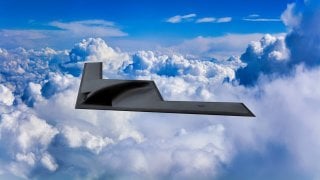The Air Force Might Kill the NGAD Fighter to Save the B-21 Raider
In an era dominated by anti-access/area-denial (A2/AD) threats, the B-21 Raider is viewed as more practical than NGAD, providing over-the-horizon capabilities to maintain U.S. power projection against emerging threats from China and beyond.
What You Need to Know: As the U.S. Air Force undergoes a period of transition amidst budget constraints, priorities are being scrutinized. The Next-Generation Air Dominance (NGAD) program, a sixth-generation fighter concept relying on AI and drone swarms, risks cancellation due to its complexity and cost.
-Instead, focus is shifting toward the B-21 Raider, a stealth bomber poised to be the world’s most advanced, with nuclear capabilities and compatibility with hypersonic cruise missiles.
-In an era dominated by anti-access/area-denial (A2/AD) threats, the B-21 is viewed as more practical, providing over-the-horizon capabilities to maintain U.S. power projection against emerging threats from China and beyond.
Air Force’s NGAD vs. B-21 Raider: A Strategic Shift in Defense Priorities
The United States Air Force is going through a period of radical, rapid transition. Not only is the Air Force, along with the rest of the US military, experiencing once-in-a-generation changes but they are going through such changes with finite levels of support and funding.
Or, rather, the funding they are receiving is being poorly allocated—and has been for many years.
Because of the newfound rising threats of China, Russia, and the recurring threats posed to the United States by rogue states, like Iran and North Korea, the Air Force wants new systems to stay ahead of these constantly evolving threats.
NGAD or N-GAG?
The Next-Generation Air Dominance (NGAD) program, which at its core is the manned sixth-generation warplane augmented by technologies like artificial intelligence (AI) and drone swarms, is the dream warplane for the Air Force. The NGAD has been described by Chinese rivals as a “system of systems.”
Yet, its complexity is going to kill the program before it even takes flight—especially considering that the United States is in the beginnings of what will likely become a significant debt crisis over the next decade.
Frankly, the Pentagon needs to become accustomed to extremely tight budgets for the foreseeable future because of the inherent systemic debt crisis unfolding before our eyes.
The B-21 is Where It’s At
At the same time that the Air Force is obsessed with its pipedream of building the NGAD system of systems, the USAF brass wants to build at least 100 B-21 long-range strategic stealth bombers.
This next-generation stealth bomber was unveiled in December, 2022, at Edwards Air Force Base. It is the world’s most advanced stealth bomber. And America needs this bird more than ever. In fact, with the F-22A Raptor and the F-35 Lightning II, the idea that the Air Force would waste its money on a sixth-generation warplane is downright foolish.
As for the B-21 Raider, it will be nuclear weapons-capable and, according to multiple reports on the otherwise secretive stealth bomber, the Air Force plans on equipping the B-21 with its still developing hypersonic cruise missiles.
That alone gives the B-21 significant advantages (and should mean greater prioritization) over the redundant and wasteful NGAD program. The B-21 is considered to be part of the Air Force’s Long-Range Stand-Off (LRSO) family of platforms.
A B-21 Radar’s radar cross-section is so small that it appears as no bigger than a mosquito. This bird is also capable of carrying drones in its bomber bays. In essence, this is the plane that the Air Force requires to remain relevant in the dynamic threat environment that the United States Armed Forces finds itself operating in.
If the Air Force is going to spend the taxpayer’s money, it must choose the best system. The NGAD, while promising incredible technological capabilities, may never take wing the way that the Air Force envisions because of the fact that the system of systems is so complex it’ll be too costly and have too many delays. The B-21, on the other hand, will be a highly valuable platform capable of delivering immense firepower over-the-horizon.
Overcoming A2/AD
In the age of anti-access/area-denial (A2/AD), conventional systems will be insufficient to the challenge presented to America’s power projection platforms. The B-21 has a large carrying capacity and can engage targets beyond the range of most Chinese A2/AD systems.
Sure, China can augment those systems over time. But, over time the strategic situation facing China might be so radically changed that they’ll have to focus more on the political and economic conditions at home and less on their near-abroad.
America just needs to buy itself time—preferably a decade—to restore its comprehensive national power relative to that of China. The B-21 Raider will help accomplish this goal from the Air Force’s perspective. The NGAD is just a waste of resources in an age of diminishing returns for the US military.
Author Experience and Expertise: Brandon J. Weichert
Brandon J. Weichert, a National Interest national security analyst, is a former Congressional staffer and geopolitical analyst who is a contributor at The Washington Times, the Asia Times, and The-Pipeline. He is the author of Winning Space: How America Remains a Superpower, Biohacked: China’s Race to Control Life, and The Shadow War: Iran’s Quest for Supremacy. His next book, A Disaster of Our Own Making: How the West Lost Ukraine, is due October 22 from Encounter Books. Weichert can be followed via Twitter @WeTheBrandon.
All images are Creative Commons or Shutterstock. All photos are of various submarine styles.
From the Vault
Russia Freaked Out: Why the U.S. Navy 'Unretired' the Iowa-Class Battleships
Battleship vs. Battlecruiser: Iowa-Class vs. Russia's Kirov-Class (Who Wins?)


